Equity Evaluation of Park Green Space Based on SDG11: A Case Study of Jinan City, Shandong Province, China
Abstract
1. Introduction
2. Materials and Methods
2.1. Study Area
2.2. Data Resource
2.3. Method
2.3.1. Entropy Value Method
- 1.
- Data standardization
- 2.
- Weight quantification
- 3.
- Composite Score Calculation
2.3.2. Two-Step Floating Catchment Area
2.3.3. Lorenz Curve and Gini Coefficient
2.3.4. Coupling and Coordination Degree Model
2.4. Methodological Workflow
2.4.1. Acquisition and Classification of PGS
2.4.2. Demand Level Quantification
2.4.3. Supply Level Measurement
- 1.
- Quantity indicator
- 2.
- Quality indicator
- 3.
- Accessibility indicator
3. Results
3.1. PGS Demand Analysis
3.2. PGS Supply Analysis
3.2.1. Quantitative Indicator Analysis
3.2.2. Quality Indicator Analysis
3.2.3. Analysis of Accessibility Indicator
3.2.4. Comprehensive Supply Level Analysis
3.3. Analysis of Supply and Demand Coordination of PGS
3.4. Measuring the Fairness of PGS Based on Gini Coefficient
3.5. Optimization Strategies for Fairness in PGS
4. Discussion
4.1. Methodological Innovation in Green Space Equity Assessment
- Holistic measurement: This study is significantly different from previous explorations that focused only on spatial accessibility [15]. While traditional studies are often limited to static analysis of spatial elements, which makes it difficult to truly touch the actual needs and experiences of residents, our approach realizes the deep coupling between spatial patterns and residents’ real needs. On the one hand, we anchor the core indicators of Sustainable Development Goal 11 (SDG11) that are closely related to the quality of life of urban residents and incorporate key elements such as housing affordability and air quality into the assessment system, which directly reflect the basic needs of residents in terms of housing costs and health environment; on the other hand, we innovatively introduce geographic big data technology by crawling and integrating online open platforms of residents’ data. This way of obtaining information based on geographic big data breaks through the limitations of traditional research data with limited sample size and insufficient timeliness and is able to reflect in real time and comprehensively the differences in the spatial use habits and needs of different groups, providing a more persuasive empirical basis for understanding the interactive relationship between urban space and residents’ needs.
- Social sensitivity: This study identifies minors (under 18) and the elderly (over 65) as PGS-vulnerable groups because cities have physiological and structural differences that make them more vulnerable. It uses the Gini coefficient to show how these groups are vulnerable in the allocation of PGS resources, echoing Wang et al.’s [23] criticism of ‘neutral’ analyses that hide power dynamics. It connects demographic data to spatial patterns, addressing concerns related to earlier aggregate scores in terms of methodology. Showing the differences in PGS quality and amenities between the north and south of Jinan is in accordance with global results [7] that are not often mentioned in Chinese research [57]. The result shows how PGS distribution may be changed for vulnerable groups, which has an effect on Jinan’s 2030 plan. Such evidence makes equity-centered analysis possible.
4.2. Vulnerable Groups and Green Space Justice
4.3. Implications for Decision-Making
- Insights at the regional level: the complete findings of the park equity assessment enable the Jinan New Urbanization Plan (2021–2035) [56] to decide how to best use resources across different administrative entities.
- Improvement of spatial effects: Finding the best locations for areas with low accessibility and for parks (Figure 18) can help with small-scale renovations, such as planning new parks in the neighborhoods that need them most to meet the needs of their residents, a strategy that has been very effective in Shanghai [15] and Padua [12].
4.4. Unaddressed Dimensions and Future Work
- User behavior data: surveys or cell phone signaling data could record, for example, how often residents visit the park [15], which could be a component of future research.
- Multiple-use benefits: assessing co-benefits such as carbon sequestration or impacts on mental health [51] extends the equity conversation beyond use.
- Temporal dynamics: tracking the long-term impacts of policy changes or urban sprawl on green space equity [63].
5. Conclusions
- The innovative value of this framework lies in its departure from conventional single-indicator analyses. In this study, a comprehensive assessment model of PGS equity (both spatial equity and social distributive justice) is constructed by integrating the indicators of SDG11, the Coupled Coordination Degree Model (CCDM), the Lorenz curve, and Gini coefficients. This connects the fairness of public green space to the larger goal of sustainable urban development and is different from basic approaches that only look at accessibility.
- Explicitly focusing on minors (under 18) and the elderly (over 65) as vulnerable groups. This is because both groups experience mobility constraints, and minors require safe recreational environments for their development, while older adults benefit from nearby green spaces. Vibrant intra-urban disparities, such as lower PGS accessibility for vulnerable groups in northern districts like Shanghe compared to southern cores like Lixia, are concealed by Jinan’s citywide per capita green space of 12 m2 and Gini coefficient of 0.35.
- These research findings provide a reference for decision-makers. Based on the evaluation results, PGS resource allocation can be guided, with priority given to northern regions. K-means clustering analysis can determine the optimal location for building new parks in areas with low accessibility, ensuring that intervention measures are consistent across the system and tailored to local conditions.
Author Contributions
Funding
Institutional Review Board Statement
Informed Consent Statement
Data Availability Statement
Acknowledgments
Conflicts of Interest
Abbreviations
| SDG | Sustainable development goal |
| PGS | Park green space |
| GIS | Geographic information systems |
| PD | Patch density |
| LPI | Largest patch index |
| LSI | Landscape shape index |
| AI | Aggregation index |
| SPLIT | Splitting index |
| MESH | Effective mesh size |
References
- Wang, Z.H.; Yan, G.G.; Wang, S.Y. Fairness Evaluation of Landscape Justice in Urban Park Green Space: A Case Study of the Daxing Part of Yizhuang New Town, Beijing. Sustainability 2023, 15, 370. [Google Scholar] [CrossRef]
- Yu, J.; Yi, L.W.; Xie, B.G.; Li, X.Q.; Li, J.H.; Xiao, J.Y.; Zhang, L. Matching and coupling coordination between the supply and demand for ecosystem services in Hunan Province, China. Ecol. Indic. 2023, 157, 111303. [Google Scholar] [CrossRef]
- Hansen, W.G. How Accessibility Shapes Land Use. J. Am. Inst. Plan. 1959, 25, 73–76. [Google Scholar] [CrossRef]
- Liston-Heyes, C.; Heyes, A. Recreational benefits from the Dartmoor National Park. J. Environ. Manag. 1999, 55, 69–80. [Google Scholar] [CrossRef]
- Erkip, F.B. The distribution of urban public services: The case of parks and recreational services in Ankara. Cities 1997, 14, 353–361. [Google Scholar] [CrossRef]
- Coutts, C.; Horner, M.; Chapin, T. Using geographical information system to model the effects of green space accessibility on mortality in Florida. Geocarto Int. 2010, 25, 471–484. [Google Scholar] [CrossRef]
- Hoffimann, E.; Barros, H.; Ribeiro, A.I. Socioeconomic Inequalities in Green Space Quality and Accessibility-Evidence from a Southern European City. Int. J. Environ. Res. Public Health 2017, 14, 916. [Google Scholar] [CrossRef] [PubMed]
- Li, M.T.; Yang, L.B.; Wei, Y. Improved Gaussian based 2-step floating catchment area method:A case study of green space accessibility in Shanghai. Prog. Geogr. 2016, 35, 990–996. [Google Scholar] [CrossRef]
- Khattak, M.M.H.; Khan, M.A.; Din, S.U.; Khan, M.Z.; Habib, M.F. Examining equity of walking accessibility to green spaces: A case study of Islamabad. Ain Shams Eng. J. 2023, 14, 102556. [Google Scholar] [CrossRef]
- Wu, J.S.; Men, X.N.; Liang, J.T.; Zhao, Y.H. Research on supply and demand equilibrium of ecosystem services in Guangdong Province based on the gini coefficient. Acta Ecol. Sin. 2020, 40, 6812–6820. [Google Scholar] [CrossRef]
- Tan, C.D.; Tang, Y.H.; Wu, X.F. Evaluation of the Equity of Urban Park Green Space Based on Population Data Spatialization: A Case Study of a Central Area of Wuhan, China. Sensors 2019, 19, 2929. [Google Scholar] [CrossRef]
- Semenzato, P.; Costa, A.; Campagnaro, T. Accessibility to urban parks: Comparing GIS based measures in the city of Padova (Italy). Urban For. Urban Green. 2023, 82, 127896. [Google Scholar] [CrossRef]
- Chen, Y.Y.; Men, H.L.; Ke, X.L. Optimizing urban green space patterns to improve spatial equity using location-allocation model: A case study in Wuhan. Urban For. Urban Green. 2023, 84, 127922. [Google Scholar] [CrossRef]
- Meng, L.; Li, L. Relationship between supply and demand of green open space in Haidian District of Beijing based on accessibility. J. Beijing For. Univ. 2023, 45, 108–119. [Google Scholar] [CrossRef]
- Xiao, Y.; Wang, D.; Fang, J. Exploring the disparities in park access through mobile phone data: Evidence from Shanghai, China. Landsc. Urban Plan. 2019, 181, 80–91. [Google Scholar] [CrossRef]
- Alfred, M. Principles of Economics, 8th ed.; University of Minnesota Libraries Publishing: Minneapolis, MN, USA, 1890. [Google Scholar]
- Wu, J.S.; Si, M.L.; Li, W.F. Spatial equity analysis of urban green space from the perspective of balance between supply and demand: A case study of Futian District, Shenzhen, China. Chin. J. Appl. Ecol. 2016, 27, 2831–2838. [Google Scholar] [CrossRef]
- Wang, M.; Zhu, A.N.; Wang, J.Q.; Lu, T.F. Supply and demand relationship of urban park green space allocation based on social equity and justice: A case study of Xuhui District, Shanghai. Acta Ecol. Sin. 2019, 39, 7035–7046. [Google Scholar] [CrossRef]
- Chen, Y.L.; Yu, P.H.; Li, Z.G.; Wang, J.; Chen, Y.Y. Environmental Equity Measurement of Urban Green Space from the Perspective of SDG11: A Case Study of the Central Urban Area of Wuhan. Geogr. Geo-Inf. Sci. 2021, 37, 81–89. Available online: https://hfgfy2b08d79e045e4fd4su9fu65c0oxcu6ooxficg.res.gxlib.org.cn/kcms2/article/abstract?v=xhAGsX4BfX4Fm4CsMOpmvWaT2Zg1IxTBnXY6Aux7zyLVt3zGt63JfSHrrKQGNzGSmk2HOx7m4f6VjRcsk9BL09MTV-21T7T6O4yMUkuezIC2XwIrpS-gUiMOmpQ4Js1RC99M6yGBYKHCBylAvuRGgV60BmFF7OCC_UfwM0-_m4Ae86s77qHEPXNEP9MENi6j&uniplatform=NZKPT&language=CHS (accessed on 18 August 2025).
- Huang, C.L.; Sun, Z.C.; Jiang, H.P.; Wang, J.H. Big Earth Data Supports Sustainable Cities and Communities: Progress and Challenges. Bull. Chin. Acad. Sci. 2021, 36, 914–922. [Google Scholar] [CrossRef]
- Abastante, F.; Lami, I.M.; Gaballo, M. Pursuing the SDG11 Targets: The Role of the Sustainability Protocols. Sustainability 2021, 13, 3858. [Google Scholar] [CrossRef]
- Akuraju, V.; Pradhan, P.; Haase, D.; Kropp, J.P.; Rybski, D. Relating SDG11 indicators and urban scaling—An exploratory study. Sustain. Cities Soc. 2020, 52, 101853. [Google Scholar] [CrossRef]
- Wang, X.; Meng, Q.; Liu, X.; Allam, M.; Zhang, L.; Hu, X.; Bi, Y.; Jancsó, T. Evaluation of Fairness of Urban Park Green Space Based on an Improved Supply Model of Green Space: A Case Study of Beijing Central City. Remote Sens. 2023, 15, 244. [Google Scholar] [CrossRef]
- Yang, J.; Huang, X. The 30 m annual land cover dataset and its dynamics in China from 1990 to 2019. Earth Syst. Sci. Data 2021, 13, 3907–3925. [Google Scholar] [CrossRef]
- Wei, J.; Li, Z.; Chen, X.; Li, C.; Sun, Y.; Wang, J.; Lyapustin, A.; Brasseur, G.; Jiang, M.; Sun, L.; et al. Separating daily 1 km PM2.5 inorganic chemical composition in China since 2000 via deep learning integrating ground, satellite, and model data. Environ. Sci. Technol. 2023, 57, 18282–18295. [Google Scholar] [CrossRef]
- Shannon, C.E. A Mathematical Theory of Communication. Bell Syst. Tech. J. 1948, 27, 379–423. [Google Scholar] [CrossRef]
- Wu, J.; Yang, S.; Zhang, X. Interaction Analysis of Urban Blue-Green Space and Built-Up Area Based on Coupling Model—A Case Study of Wuhan Central City. Water 2020, 12, 2185. [Google Scholar] [CrossRef]
- Ji, Y.Y.; Zh, L.J. Comparative analysis of spatial–temporal differences in sustainable development between the Yangtze River Economic Belt and the Yellow River Economic Belt. Environ. Dev. Sustain. 2023, 25, 979–994. [Google Scholar] [CrossRef]
- Chen, J.; Zhang, Y.L.; Chen, Z.Y.; Nie, Z.L. Improving assessment of groundwater sustainability with analytic hierarchy process and information entropy method: A case study of the Hohhot Plain, China. Environ. Earth Sci. 2015, 73, 2353–2363. [Google Scholar] [CrossRef]
- Yin, H.Y.; Xiao, R.; Fei, X.F.; Zhang, Z.H.; Gao, Z.; Wan, Y.; Tan, W.f.; Jiang, X.C.; Cao, W.; Guo, Y.X. Analyzing “economy-society-environment” sustainability from the perspective of urban spatial structure: A case study of the Yangtze River delta urban agglomeration. Sustain. Cities Soc. 2023, 96, 104691. [Google Scholar] [CrossRef]
- Xun, J.; Zhang, M.; Xu, G.F.; Guo, X.Y. Diversity and Influencing Factors of Public Service Facilities in Urban (Suburban) Railway Life Circle—Evidence from Beijing Subway Line S1, China. Land 2024, 13, 1286. [Google Scholar] [CrossRef]
- Wang, F. Quantitative Methods and Applications in GIS, 1st ed.; CRC Press: Boca Raton, FL, USA, 2006. [Google Scholar]
- Zheng, Z.C.; Shen, W.; Li, Y.; Qin, Y.C.; Wang, L. Spatial equity of park green space using KD2SFCA and web map API: A case study of zhengzhou, China. Appl. Geogr. 2020, 123, 102310. [Google Scholar] [CrossRef]
- Lin, Y.Q.; Liu, Y.B.; Ouyang, Z.Y.; Meng, C.; Xiao, Y. Mechanisms and influencing factors of cultural ecosystem services value realization. Environ. Sustain. Indic. 2025, 26, 100584. [Google Scholar] [CrossRef]
- Ke, X.L.; Huang, D.Y.; Zhou, T.; Men, H.L. Contribution of non-park green space to the equity of urban green space accessibility. Ecol. Indic. 2023, 146, 109855. [Google Scholar] [CrossRef]
- Lorenz, M.O. Methods of Measuring the Concentration of Wealth. Publ. Am. Stat. Assoc. 1905, 9, 209–219. [Google Scholar] [CrossRef]
- Zhou, Y.; Xie, H.; Liu, X.; Wang, X.; Wang, Z. From service capacity to spatial equity: Accurately and comprehensively evaluating urban park green space distribution under multi-trips mode. PLoS ONE 2024, 19, e0296629. [Google Scholar] [CrossRef]
- Drezner, T.; Drezner, Z.; Guyse, J. Equitable service by a facility: Minimizing the Gini coefficient. Comput. Oper. Res. 2009, 36, 3240–3246. [Google Scholar] [CrossRef]
- Rao, Y.X.; Zhong, Y.; He, Q.S.; Dai, J.Y. Assessing the Equity of Accessibility to Urban Green Space: A Study of 254 Cities in China. Int. J. Environ. Res. Public Health 2022, 19, 4855. [Google Scholar] [CrossRef]
- Song, H.F.; Tian, W.; Wang, Y.M.; Zhang, Z. Regional high-quality development evaluation and spatial balance analysis. Procedia Comput. Sci. 2022, 214, 1032–1039. [Google Scholar] [CrossRef]
- Zhang, Y.; Zhu, T.X.; Guo, H.Y.; Yang, X.H. Analysis of the coupling coordination degree of the Society-Economy-Resource-Environment system in urban areas: Case study of the Jingjinji urban agglomeration, China. Ecol. Indic. 2023, 146, 109851. [Google Scholar] [CrossRef]
- Bi, Y.Z.; Zheng, L.; Wang, Y.; Li, J.F.; Yang, H.; Zhang, B.W. Coupling relationship between urbanization and water-related ecosystem services in China’s Yangtze River economic Belt and its socio-ecological driving forces: A county-level perspective. Ecol. Indic. 2023, 146, 109871. [Google Scholar] [CrossRef]
- Qu, W.; Lian, H.; Wang, Y.; Ma, Y. Spatiotemporal Evolution of the Coupling Coordination Relationship of “Population–Environment” Development in the Xi’an Metropolitan Area. Sustainability 2023, 15, 4533. [Google Scholar] [CrossRef]
- Lu, C.; Li, S.; Liu, J.; Xu, K. Coupling Coordination and Dynamic Response Analysis of New-Type Urbanization, Urban Infrastructure and Urban Environment—A Case Study of the Jiaodong Economic Circle. Environ. Res. Public Health 2022, 19, 14909. [Google Scholar] [CrossRef] [PubMed]
- Tong, A.Q.; Xu, L.H.; Ma, Q.W.; Shi, Y.J.; Feng, M.; Lu, Z.W.; Wu, Y.Q. Evaluation of the level of park space service based on the residential area demand. Urban For. Urban Green. 2024, 93, 128214. [Google Scholar] [CrossRef]
- GB/T 51346-2019; Standard for Planning of Urban Green Space. National Standard of the People’s Republic of China: Beijing, China, 2019; pp. 10–20. Available online: https://www.mohurd.gov.cn/gongkai/zc/wjk/art/2019/art_17339_242194.html (accessed on 18 August 2025).
- Belén, M.; Ortega, E.; Rodrigo, C.W.; Antonio, L.; Andrea, D.M. Assessing road network resilience: An accessibility comparative analysis. Transp. Res. Part D Transp. Environ. 2021, 95, 102851. [Google Scholar] [CrossRef]
- Suhaida, M.S.; Tawil, N.M.; Hamzah, N.; Che-Ani, A.I.; Basri, H.; Yuzainee, M.Y. Housing Affordability: A Conceptual Overview for House Price Index. Procedia Eng. 2011, 20, 346–353. [Google Scholar] [CrossRef]
- Jing, Y.; Cui, J.X.; Ma, D.; Chen, Y.Y. Editorial: Towards sustainable urban development: Use of geographic big data for spatial planning. Front. Environ. Sci. 2023, 11, 1202661. [Google Scholar] [CrossRef]
- Guo, R.; Ann Diehl, J.; Zhang, R.; Wang, H.C. Spatial equity of urban parks from the perspective of recreational opportunities and recreational environment quality: A case study in Singapore. Landsc. Urban Plan. 2024, 247, 105065. [Google Scholar] [CrossRef]
- Yue, H.B.; He, C.Y.; Huang, Q.X.; Zhang, D.; Shi, P.J.; Moallemi, E.A.; Xu, F.J.; Yang, Y.; Qi, X.; Ma, Q.; et al. Substantially reducing global PM2.5-related deaths under SDG3.9 requires better air pollution control and healthcare. Nat. Commun. 2024, 15, 2729. [Google Scholar] [CrossRef]
- Zhao, Z.X.; Pan, Y.; Zhu, J.; Wu, J.X.; Zhu, R. The Impact of Urbanization on the Delivery of Public Service–Related SDGs in China. Sustain. Cities Soc. 2022, 80, 103776. [Google Scholar] [CrossRef]
- Zhao, Y.Q.; Gong, P. Optimal site selection strategies for urban parks green spaces under the joint perspective of spatial equity and social equity. Front. Public Health 2024, 12, 1310340. [Google Scholar] [CrossRef] [PubMed]
- Ma, J.H.; Wang, X.F.; Zhou, J.T.; Jia, Z.X.; Feng, X.M.; Wang, X.X.; Zhang, X.R.; Tu, Y.; Yao, W.J.; Sun, Z.C.; et al. Exploring the response of ecosystem services to landscape change: A case study from eastern Qinghai province. J. Geogr. Sci. 2023, 33, 1897–1920. [Google Scholar] [CrossRef]
- Yan, W.Q.; Wang, S.J. Analysis on the spatial accessibility of parks and green spaces and optimal site selection—Taking Weifang prefecture-level city as an example. IOP Conf. Ser. Earth Environ. Sci. 2021, 865, 012020. [Google Scholar] [CrossRef]
- Government, Jinan Municipal People’s. Jinan New Urbanization Plan (2021–2035). 2022. Available online: http://www.jinan.gov.cn/art/2022/7/15/art_2612_4924052.html?xxgkhide=1http://www.jinan.gov.cn/art/2022/7/15/art_2612_4924052.html?xxgkhide=1 (accessed on 18 August 2025).
- Huang, Y.; Yu, P.; Xie, P. Analysis and Optimized Location Selection of Comprehensive Green Space Supply in the Central Urban Area of Hefei Based on GIS. Buildings 2023, 13, 2731. [Google Scholar] [CrossRef]
- Wang, C.X.; Huang, S.Y.; Deng, M.T.; Wei, W. Research on Equity of Park Green Spaces in High-density Cities from the Perspective of Supply-demand Coupling Coordination: A Case Study of Longhua District, Shenzhen. Chin. Landsc. Archit. 2023, 39, 79–84. [Google Scholar] [CrossRef]
- Yang, J.P. Research on optimization strategies for urban park green space planning in Nanjing based on GIS from the perspectives of network analysis and Thiessen polygon theory. Int. J. Mod. Phys. C 2023, 36, 2441002. [Google Scholar] [CrossRef]
- Fan, F.X.; Zheng, R.X.; Zeng, C.R.; Xu, H.Y.; Wang, X.X.; Tian, G.L.; Wang, S.H.; Wang, C.; Liu, P.F.; Shu, C.Z. Synergistically dissipating the local strain and restraining lattice oxygen escape by fine-tuning of microstructure enabling Ni-rich cathodes with superior cyclabilities. J. Energy Chem. 2025, 105, 24–34. [Google Scholar] [CrossRef]
- Jin, M.J.; Deng, Q.T.; Wang, S.Y.; Wei, L.T. Equity Evaluation of Elderly-Care Institutions Based on Ga2SFCA: The Case Study of Jinan, China. Sustainability 2023, 15, 16943. [Google Scholar] [CrossRef]
- Zhang, S.J.; Yu, P.H.; Chen, Y.Y.; Jing, Y.; Zeng, F.X. Accessibility of Park Green Space in Wuhan, China: Implications for Spatial Equity in the Post-COVID-19 Era. Int. J. Environ. Res. Public Health 2022, 19, 5440. [Google Scholar] [CrossRef] [PubMed]
- Gao, J.; Zhang, Z.H.; Li, W.Y.; Sun, F.Y.; Hu, Y.N.; Wang, L.X.; Fu, J.; Li, X.; Cheng, G.D. Urban Sustainable Development Evaluation with Big Earth Data: Data, Indicators, and Methods. Bull. Chin. Acad. Sci. 2021, 36, 940–949. [Google Scholar] [CrossRef]
- Gu, K.; Liu, J.M.; Wang, D.; Dai, Y.; Li, X.Y. Analyzing the Supply and Demand Dynamics of Urban Green Spaces Across Diverse Transportation Modes: A Case Study of Hefei City’s Built-Up Area. Land 2024, 13, 1937. [Google Scholar] [CrossRef]
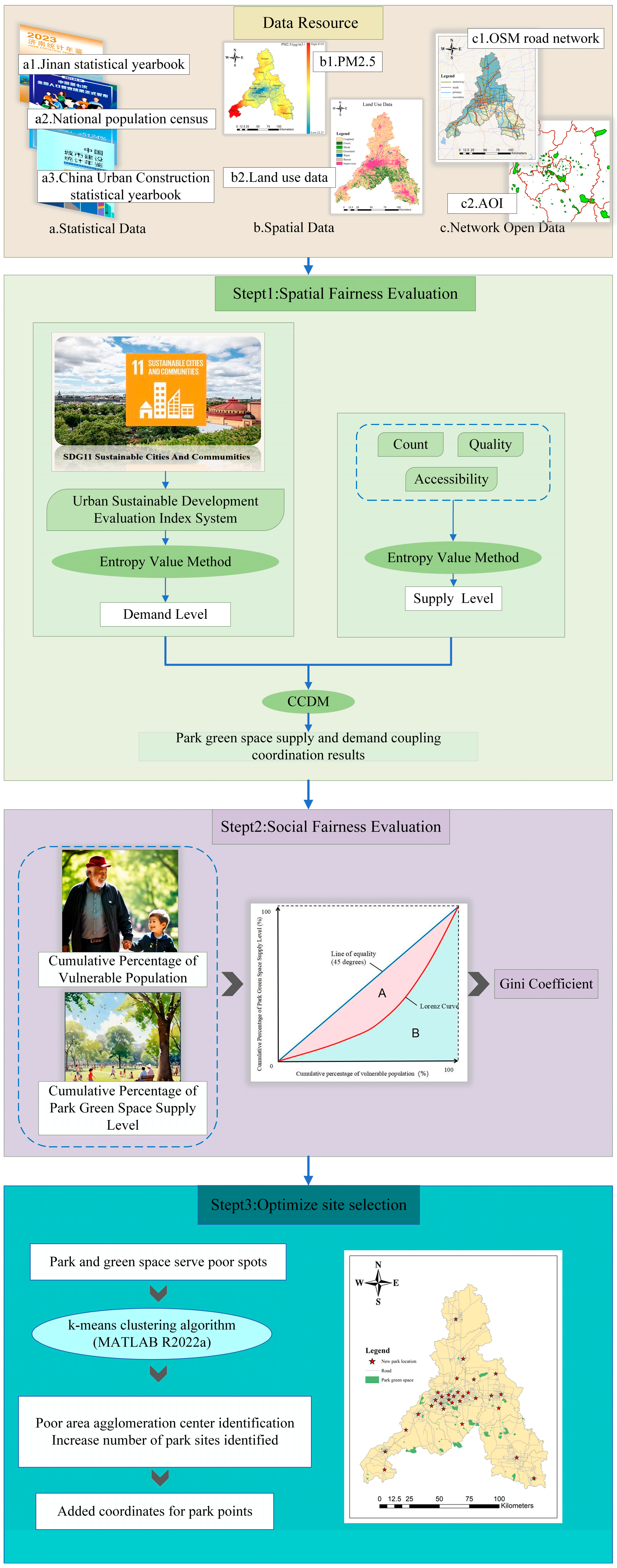

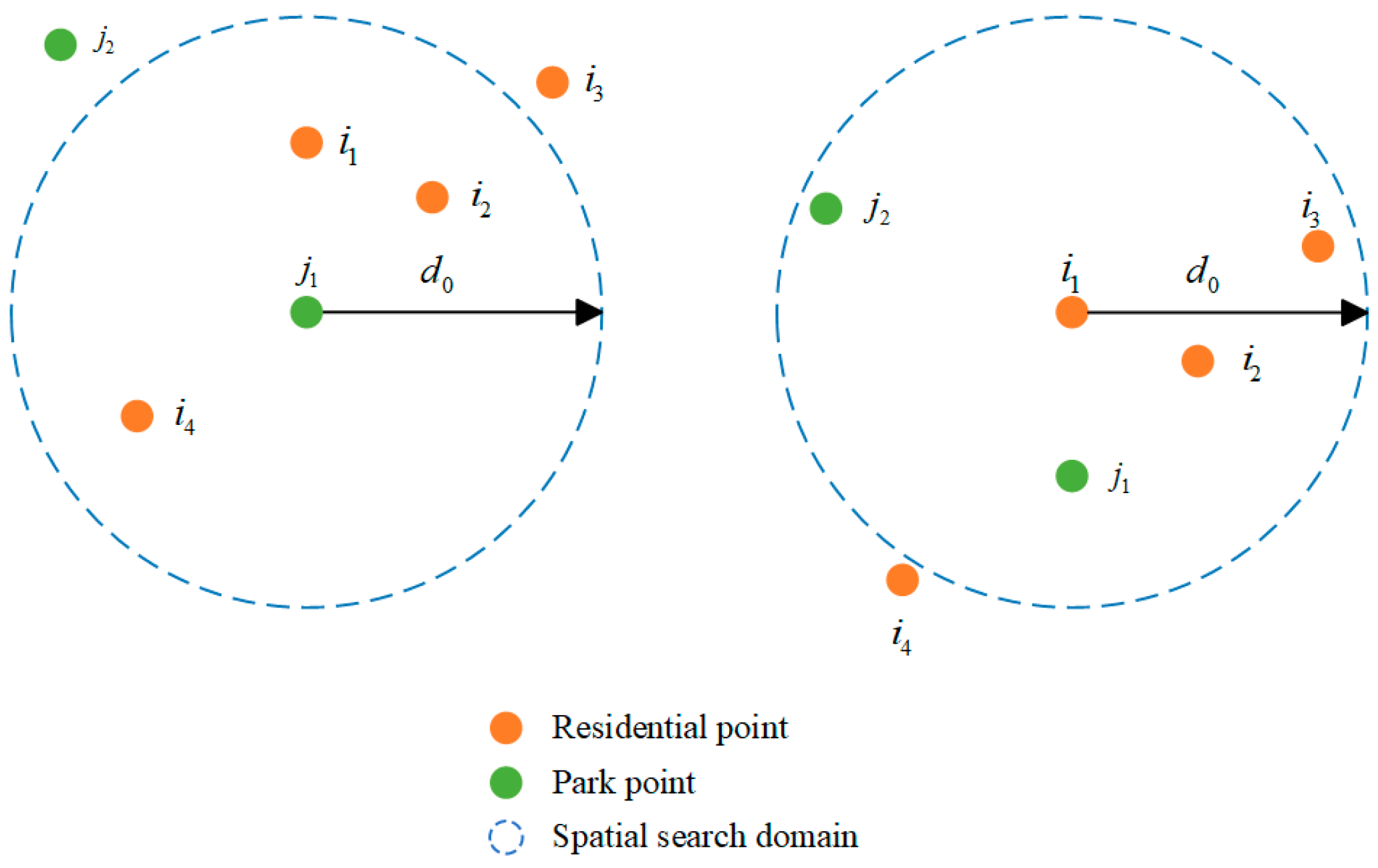
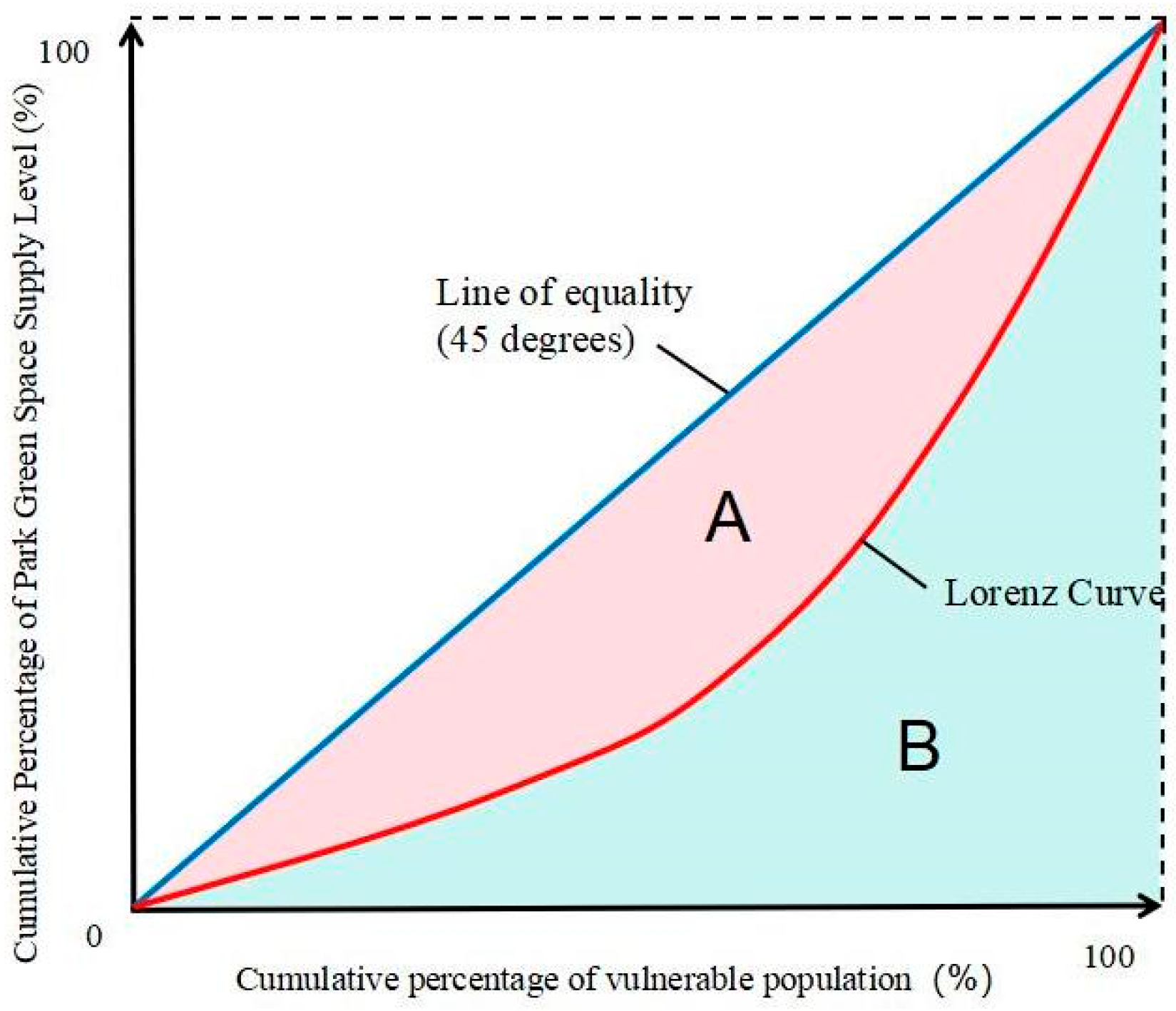
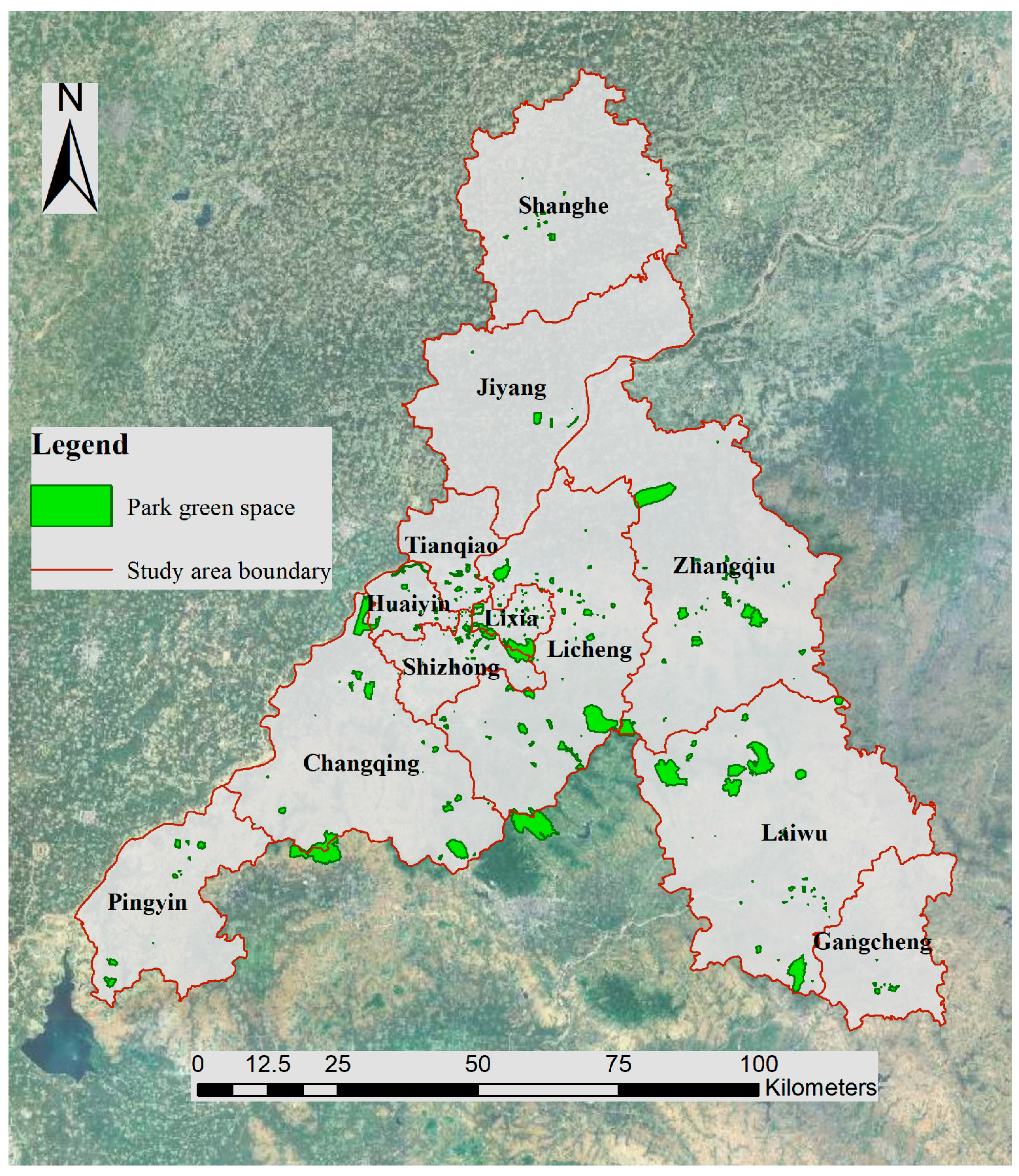

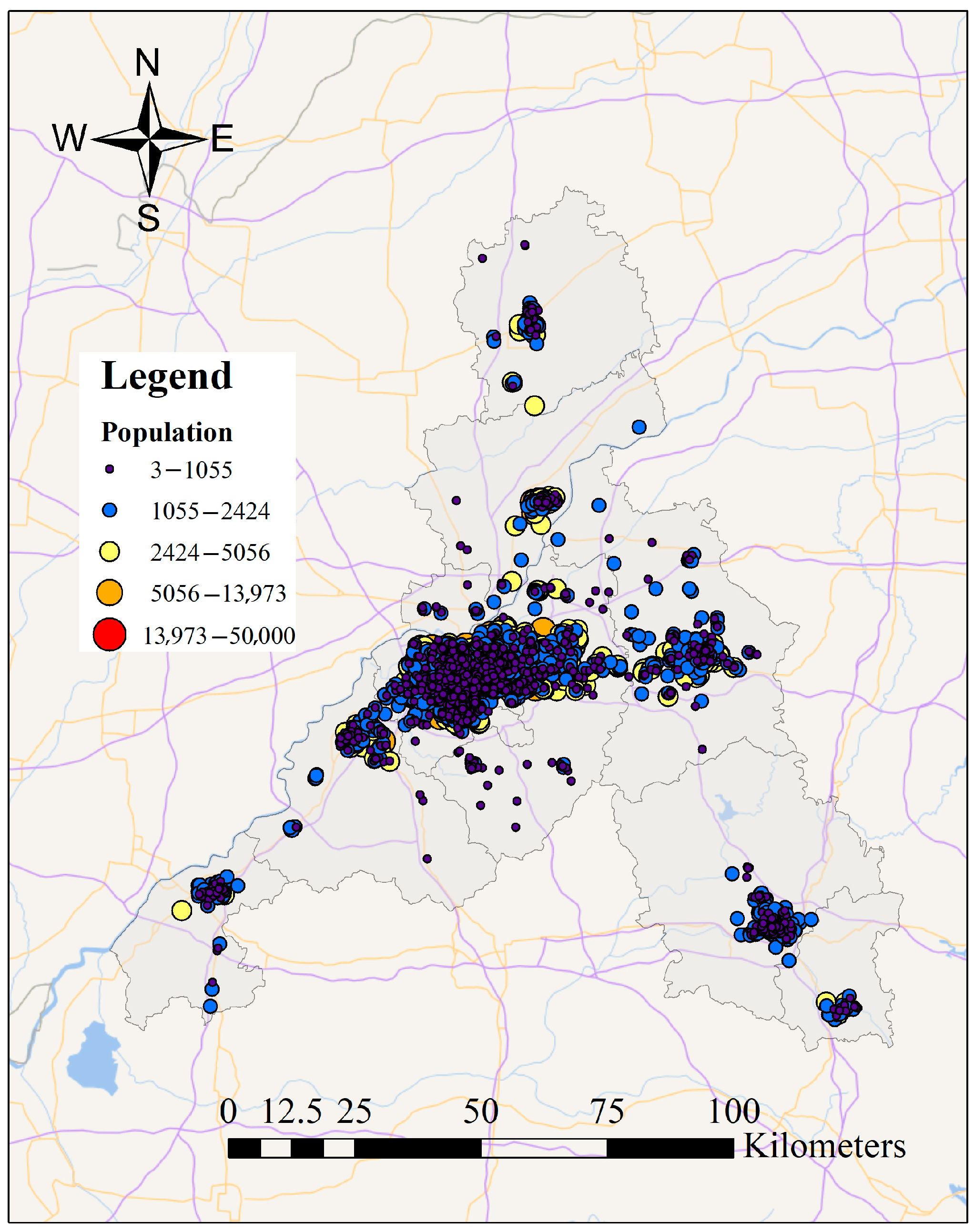
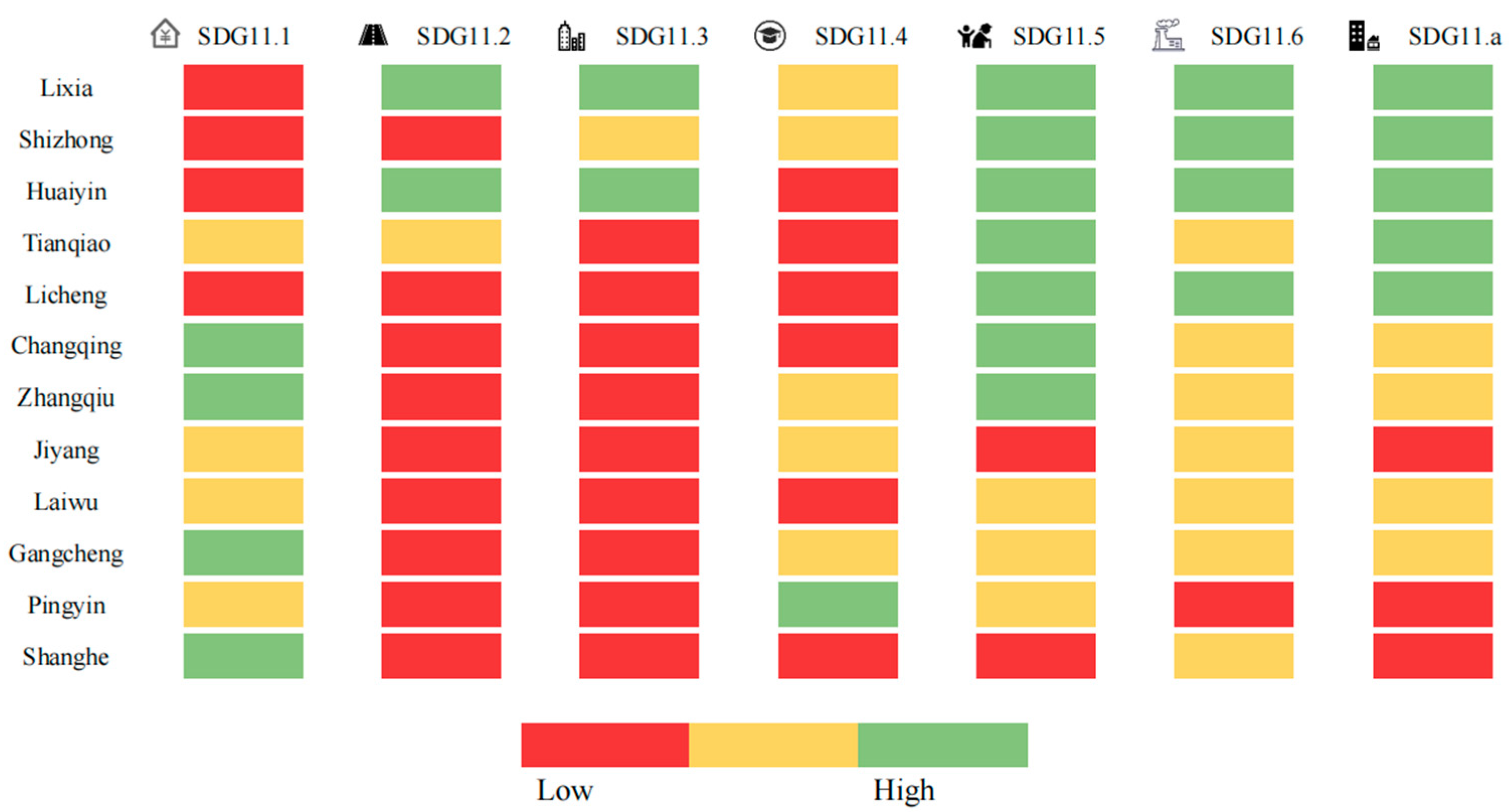
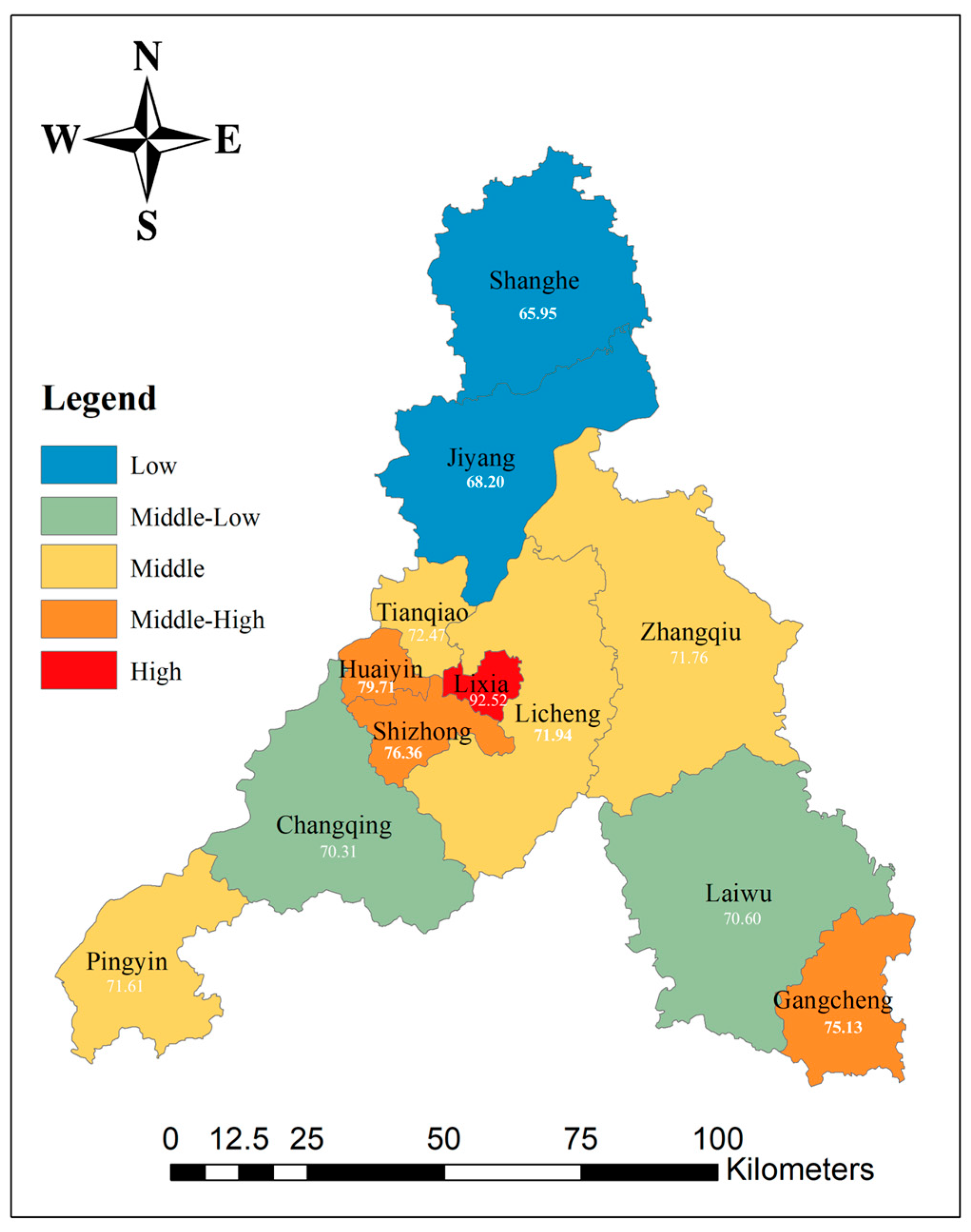
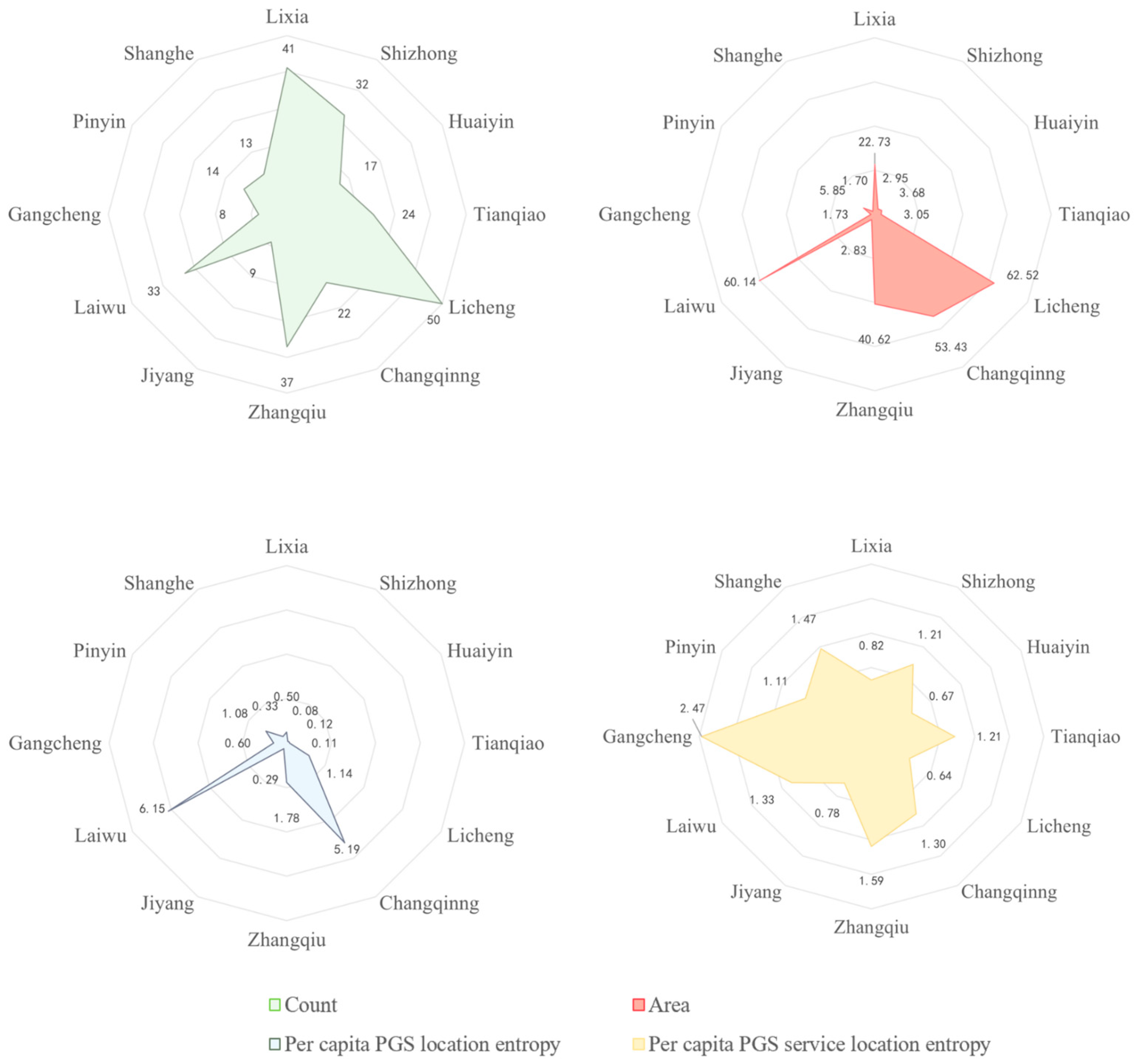
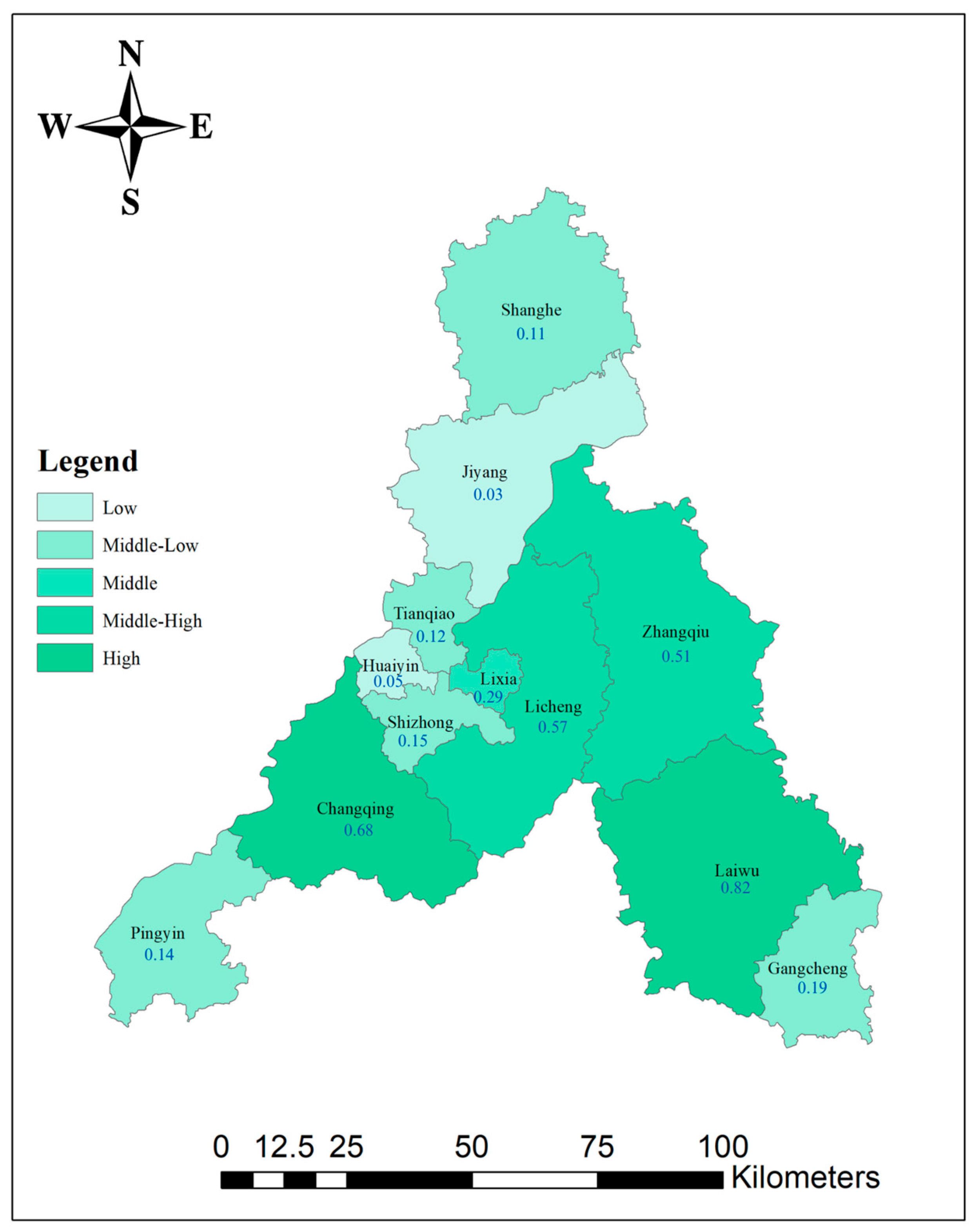
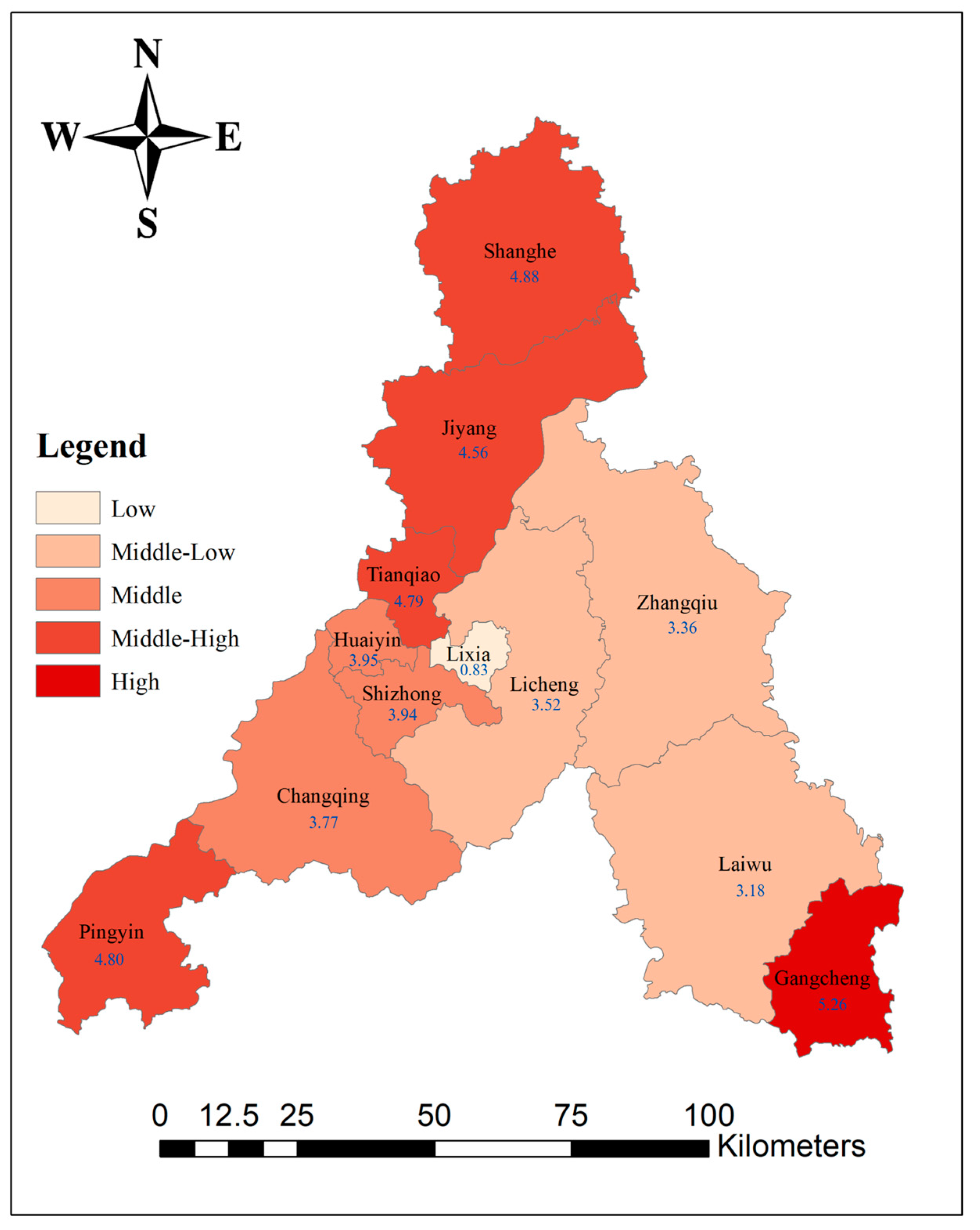

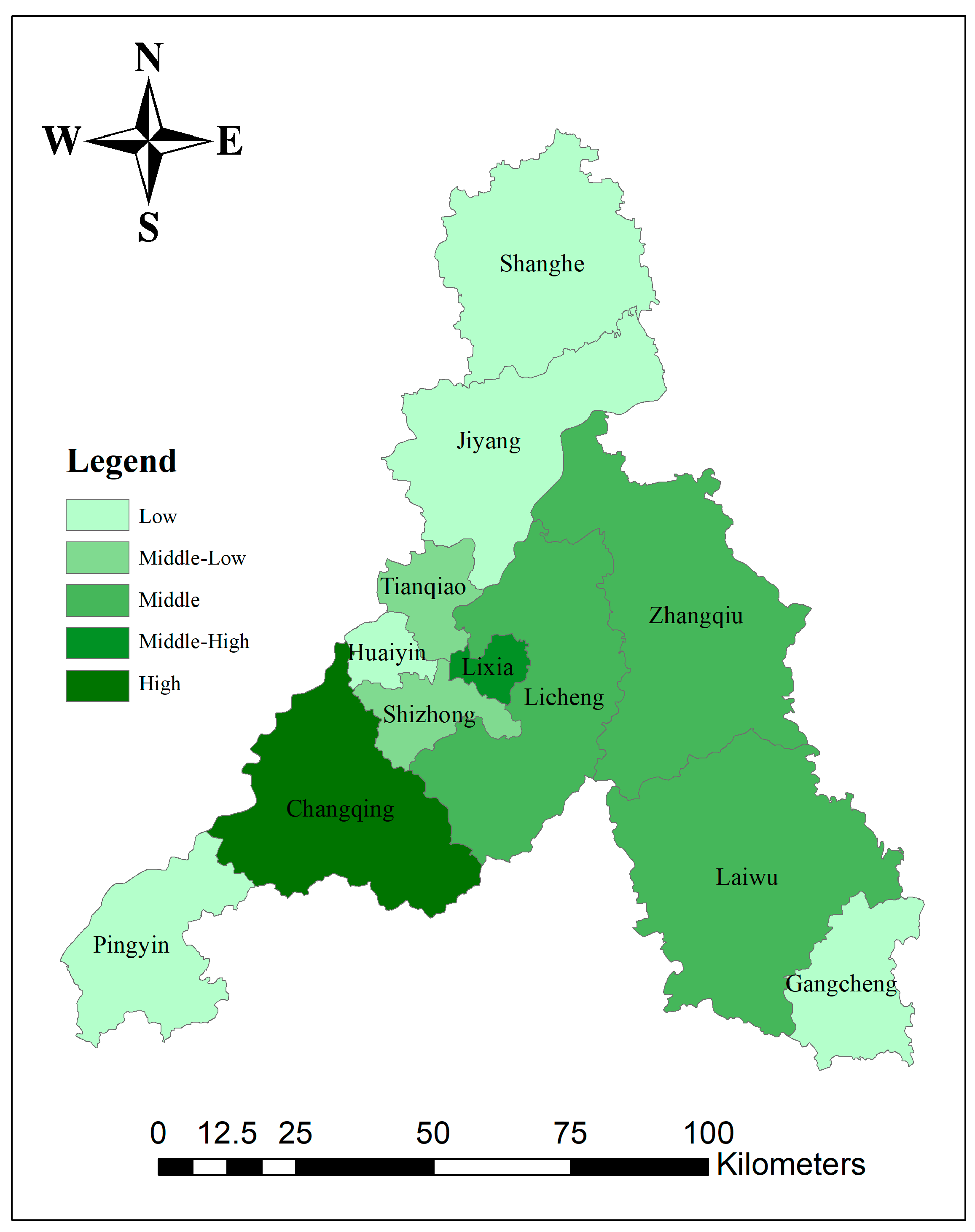
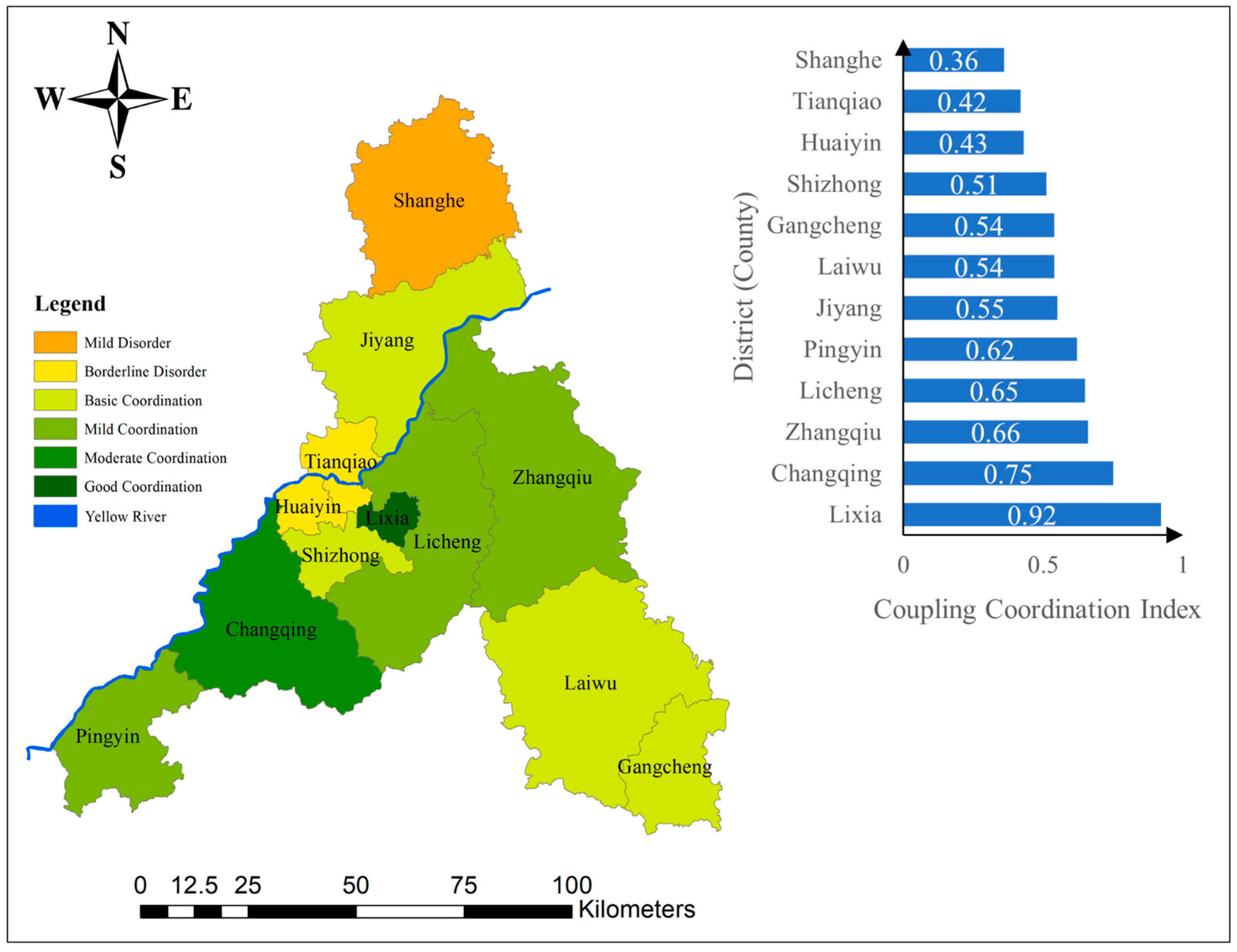
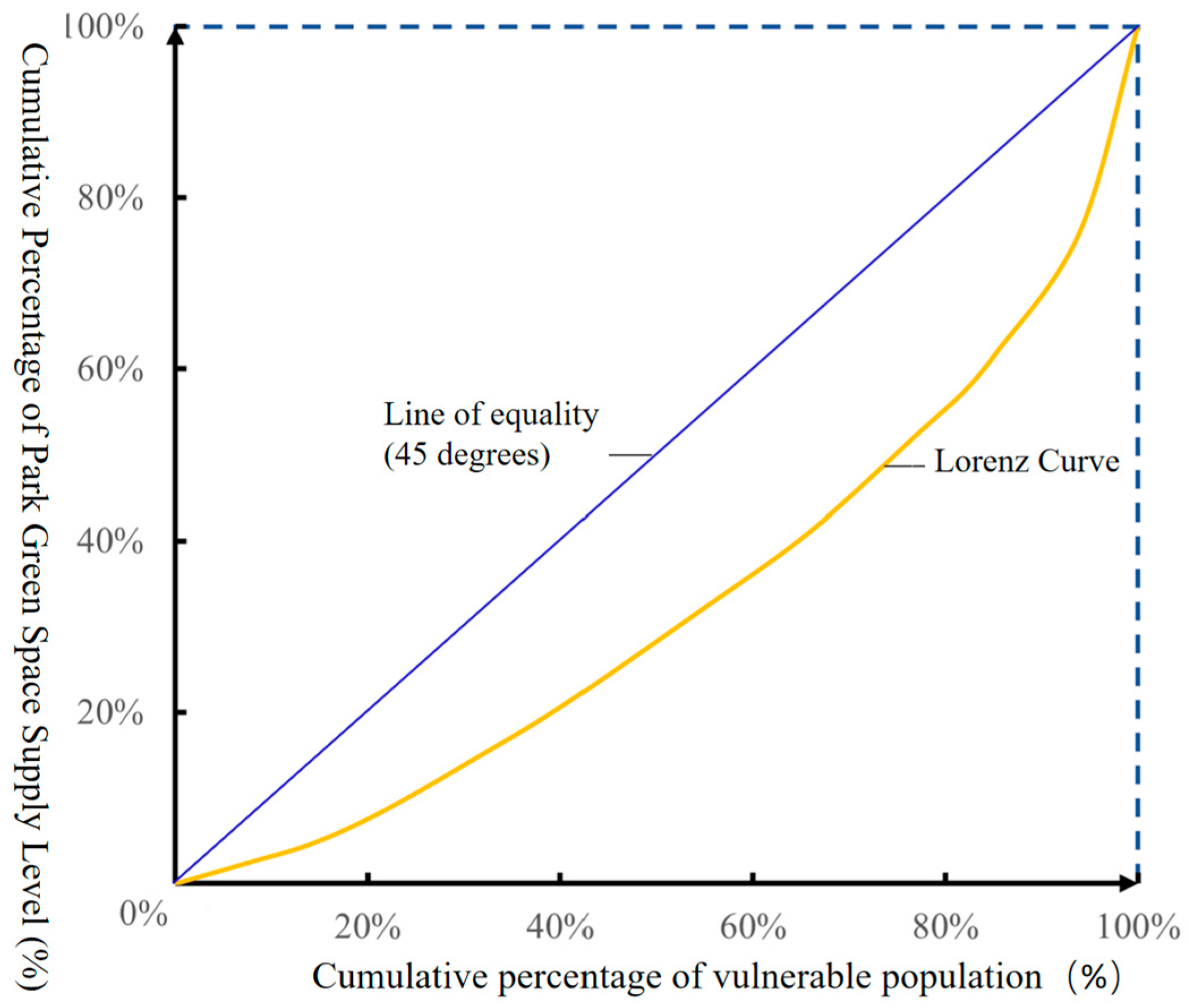

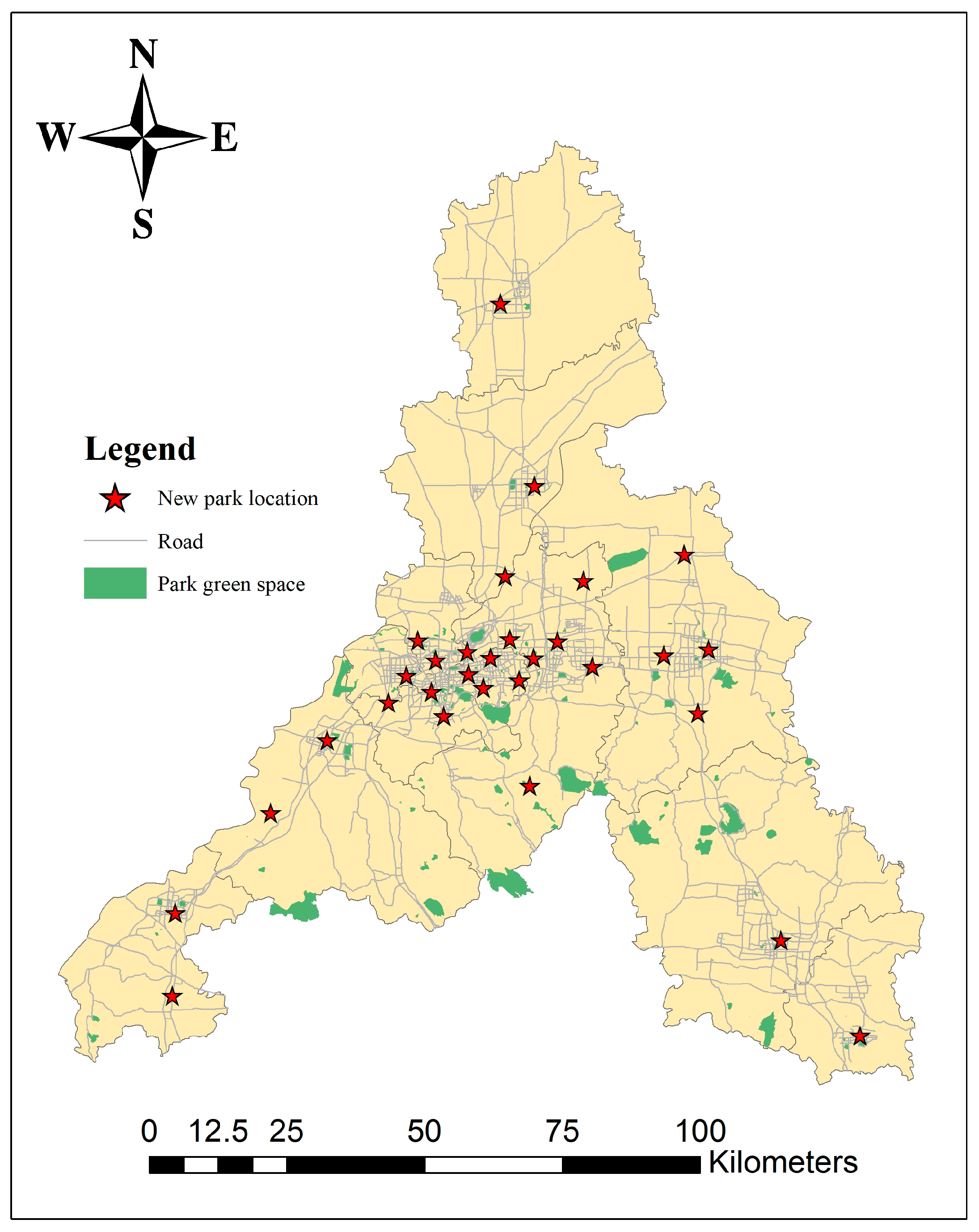
| Type | Data | Source |
|---|---|---|
| Statistical data | Statistical yearbook | http://jntj.jinan.gov.cn/art/2023/12/21/art_27523_4750235.html (accessed on 18 August 2025) |
| National population census | https://www.stats.gov.cn/sj/pcsj/rkpc/d7c (accessed on 18 August 2025) | |
| China urban construction statistical yearbook | https://www.mohurd.gov.cn/gongkai/fdzdgknr/sjfb/tjxx/jstjnj/index.html (accessed on 18 August 2025) | |
| Spatial data | Land use data [24] | https://zenodo.org/record/8176941 (accessed on 21 August 2025) |
| PM2.5 data [25] | https://data.tpdc.ac.cn/zh-hans/data/6168e75d-93ab-4e4a-b7ff-33152e49d0bf (accessed on 18 August 2025) | |
| Web-based open data | OSM data | http://planet.openstreetmap.org (accessed on 21 August 2025) |
| POI/AOI data | https://www.amap.com (accessed on 21 August 2025) |
| Type | Area (hm2) | Scope of Services (m) |
|---|---|---|
| Comprehensive Park | >50 | 3000 |
| 20–50 | 2000 | |
| 10–20 | 1000 | |
| Community Park | 5–10 | 800 |
| 1–5 | 500 | |
| Playground | <1 | 300 |
| Specialized Park | / | Determine the scope of services based on the size of the area |
| Category | SDG11 Indicator | Proxy Indicators | Explanations |
|---|---|---|---|
| Housing conditions | SDG 11.1 | Urban Housing Price-to-Income Ratio | [48] |
| Urban construction | SDG11.2 | Road Network Density | [47] |
| Urban construction | SDG11.3 | Constructed Area | The area within the urban administrative area that has actually been developed and constructed, and the municipal public facilities and public facilities are basically equipped [49]. |
| Cultural protection | SDG11.4 | Location Entropy of Cultural Venues | where Q is locational entropy, Lij Li denotes the sum of the j factors in region i, Lkj denotes the sum of the j factors in region y and Lk denotes the sum of the factors in region k [50]. |
| Vulnerable groups | SDG11.5 | Proportion of the vulnerable population | Minors and the elderly are two groups that are relatively disadvantaged socially, economically, and in terms of health and require appropriate policies and services. In this study, minors under the age of 18 and older persons over the age of 65 are collectively referred to as the “vulnerable population” [13,19]. |
| Air pollution | SDG11.6 | Annual average PM2.5 concentration | This indicator reflects the annual average concentration of fine suspended particles with a diameter of less than 2.5 μm. Good air quality is the basis for a healthy life for urban residents and sustainable urban development [51]. |
| Urban-rural coordination | SDG11.a | Urbanization rate | The urbanization rate is a direct reflection of the distribution of the population between urban and rural areas [52]. |
| Classification | Index Name | Describe | Unit |
|---|---|---|---|
| Density index | PD | patch density | /100 hm2 |
| Area indicator | LPI | The proportion of the largest patch to the landscape area | % |
| MESH | The ratio of the sum of squares of patch areas in the landscape to the total landscape area | hm2 | |
| AREA_AM | Weighted size of plaque area | hm2 | |
| Shape index | SHAPE_MN | Average shape index of plaques | / |
| LSI | Landscape Shape Index | / | |
| Aggregation and dispersion index | AI | Connectivity between patches of each landscape type | % |
| Other indicators | SPLIT | Separation degree of distribution of different patch numbers in a certain landscape | / |
| DIVISION | The degree of fragmentation of landscape segmentation | / |
| Type | Name | Area/hm2 | Park Boundaries and Gates |
|---|---|---|---|
| Comprehensive Park | Daming Lake Park | 103.97 | 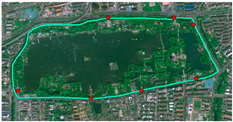 |
| Community Park | Tangye Park | 7.63 | 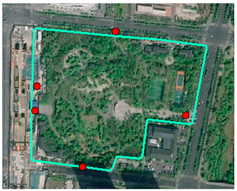 |
| Specialized Park | Jinan Zoo | 56.29 | 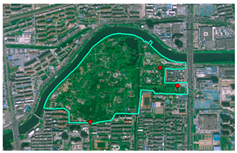 |
| Playground | Quan Cheng Impression Garden | 0.28 | 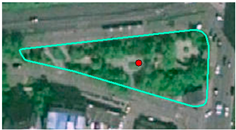 |
| Indicators | SDG11.1 | SDG11.2 | SDG11.3 | SDG11.4 | SDG11.5 | SDG11.6 | SDG11.a |
|---|---|---|---|---|---|---|---|
| Weight | 0.09 | 0.15 | 0.28 | 0.16 | 0.09 | 0.07 | 0.16 |
| Indicators | Weight |
|---|---|
| Count | 0.17 |
| Area | 0.35 |
| Per capita PGS location entropy | 0.33 |
| Per capita PGS service location entropy | 0.16 |
Disclaimer/Publisher’s Note: The statements, opinions and data contained in all publications are solely those of the individual author(s) and contributor(s) and not of MDPI and/or the editor(s). MDPI and/or the editor(s) disclaim responsibility for any injury to people or property resulting from any ideas, methods, instructions or products referred to in the content. |
© 2025 by the authors. Licensee MDPI, Basel, Switzerland. This article is an open access article distributed under the terms and conditions of the Creative Commons Attribution (CC BY) license (https://creativecommons.org/licenses/by/4.0/).
Share and Cite
Sui, M.; Sun, Y.; Meng, W.; Song, Y. Equity Evaluation of Park Green Space Based on SDG11: A Case Study of Jinan City, Shandong Province, China. Appl. Sci. 2025, 15, 9239. https://doi.org/10.3390/app15179239
Sui M, Sun Y, Meng W, Song Y. Equity Evaluation of Park Green Space Based on SDG11: A Case Study of Jinan City, Shandong Province, China. Applied Sciences. 2025; 15(17):9239. https://doi.org/10.3390/app15179239
Chicago/Turabian StyleSui, Mingxin, Yingjun Sun, Wenxue Meng, and Yanshuang Song. 2025. "Equity Evaluation of Park Green Space Based on SDG11: A Case Study of Jinan City, Shandong Province, China" Applied Sciences 15, no. 17: 9239. https://doi.org/10.3390/app15179239
APA StyleSui, M., Sun, Y., Meng, W., & Song, Y. (2025). Equity Evaluation of Park Green Space Based on SDG11: A Case Study of Jinan City, Shandong Province, China. Applied Sciences, 15(17), 9239. https://doi.org/10.3390/app15179239






